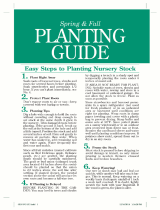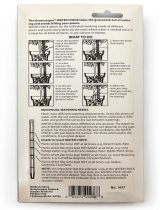Page is loading ...

Before you put any plants into the ground, you should draw a sketch of the garden area so
you can plan how many plants you want and where they will go. Once you have com-
pleted this sketch, use stakes to mark out where different rows will be planted. Set up your
trellises or set in stout stakes for climbing plants such as peas and beans. Create mounds
on which you will put in the vining plants such as cucumbers, pumpkins and melons.
1
Preparing the Soil: Fertile, well drained soil
is necessary for a successful garden. The exact
type of soil is not as important as the soil being well
drained, well supplied with organic matter, reason-
ably free of stones and moisture retentive. Keep in
mind that infertile soil that has good physical proper-
ties can be made productive by using organic matter,
lime, commercial fertilizer and other soil-improving
materials. Soils should not be plowed or worked
while it is very wet unless the work will certainly
be followed by severe freezing weather. If the soil
sticks together in a ball and does not readily crumble
under slight pressure by the thumb and finger, it is
too wet for plowing or working—because in this
condition it will cake as it dries—making it unsuit-
able for young plants.
If your garden has already been cultivated and used
in past years, there is little to do other than to plow in
additional organic material and fertilizers. The fertil-
izer may be in the form of composted manure or any
good commercial complete plant food distributed at
a rate of 3 or 4 pounds for every thousand square feet
of vegetable garden. When manure is added to the
soil, it must be composted prior to planting because
fresh, hot manure will also burn your plants.
Different types of vegetables require varying degrees
of soil acidity. The acidity or alkalinity of the soil is
measured by pH, and must be adjusted according to
which crop will occupy that area. Generally, soils in
moist climates are acidic and those in dry climates
are alkaline. A soil with a pH lower than 7.0 is an
acid soil and one with a pH higher than 7.0 is alka-
line. You can use our Soil Analyzer to test your soil.
Once you have determined the pH, you can amend
the soil as needed.
Once your soil structure, fertility and pH have been
established, the soil should be tilled one last time and
then raked smooth. Your soil is now ready for seeds
or plants. Planting depths and spacing are critical, so
don’t crowd too many plants into the allotted space
or you may end up with spindly plants and no food.
Be sure to place a tag or marker on each row or area
so that you will know what to expect to sprout there
and when! Water your garden thoroughly the day
before you intend to plant.
2
Setting in Vegetable Plants: If you purchased
bedding plants, or started your seeds indoors
in pots, dig a small hole which is slightly wider and
deeper than the root ball of the new plant. Water the
plant thoroughly prior to planting it in the garden to
lessen the shock of transplant. Gently tap the pot to
loosen the roots and remove the new plant. If the root
ball is tangled and compacted, use your fingertips to
gently loosen the outer roots. Set the plant into the
hole slightly deeper than the depth of the growing pot,
and firm the soil in around it, making certain that there
is good soil to root contact. Water in well.
GROW • IT • GUIDE
Planting Your Vegetable Garden
Order Online at Gurneys.com
GUSG-18.indd 1 2/8/2018 12:38:46 PM

®
CAUTION: Not all plant material is edible. Though most plants are harmless,
some contain toxic substances that can cause headaches, nausea, dizziness
or other discomforts. As a general rule, only known food plants should be eaten. In
case of ingestion, please contact your local poison control center at once and provide
them with the name of the ingested plant.
We’d Like to Help in Any Way We Can
The number to call is listed below:
513-354-1492
24 hours a day, 7 days a week.
Online at
Gurneys.com
P.O. Box 4178, Greendale, IN 47025-4178
© 2018 Scarlet Tanager LLC, d/b/a Gurney’s Seed and Nursery Co. All rights reserved.
Gurney’s trademarks are trademarks of Scarlet Tanager LLC.
GURNEY’S NO-RISK GUARANTEE
We want you to be satisfied. If you’re not happy with one of our products, we’ll
replace it, give you a credit or refund your money for the full amount of your
purchase price. All nursery stock, trees, plants, seeds and merchandise are guar-
anteed for one full year.
3
Maintenance Tips as Your Garden Grows:
During dry periods, vegetable gardens need
extra watering. Most vegetables benefit from an
inch or more water each week, especially when
they are fruiting.
• Mulching between the rows will help to
control weeds, conserve moisture in the soil
and provide you with pathways to access your
plants. Black plastic may be used, or you can
use grass clippings, straw, wood chips or
garden debris.
• Throughout the growing season, you should
stay on top of insect pests. Discovering a bug
problem early will make it much easier to take
appropriate action and eliminate the pests. Do
not use pesticides once the plants have fruited
unless it becomes an absolute necessity, and
be sure to follow the manufacturer’s recom-
mendations.
• Weeds rob your vegetables of water, light and
root space. If you keep them pulled regularly (try
to get the entire root) the job isn’t too bad. If they
are allowed to go to seed, you may be dealing
with thousands of weeds instead of a few.
• Once you have harvested your crop, put the
spent plant and other vegetable matter into your
compost pile so that it can be recycled into your
garden next spring.
GU-SG-18
Printed in the U.S.A.
GUSG-18.indd 2 2/8/2018 12:38:46 PM
/







